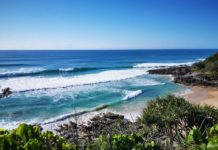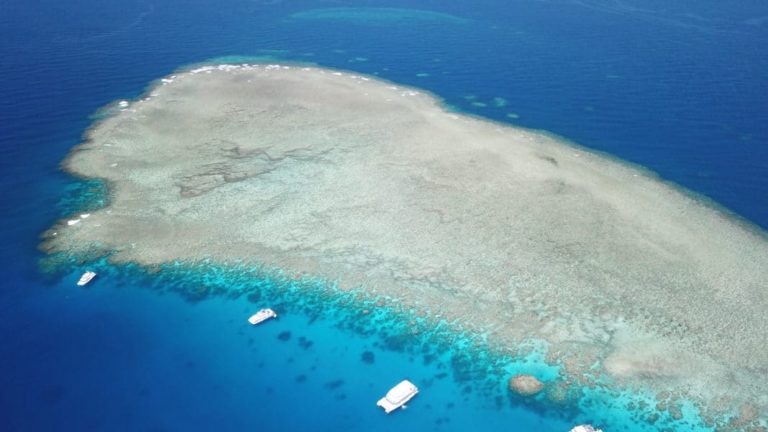
Stretching for 2300km, the Great Barrier Reef extends from the northeastern tip of Australia to the level of Bundaberg (in the state of Queensland). Longer than the Great Wall of China and visible from the moon, it has been a UNESCO World Heritage Site since 1981. We’ll tell you everything about this natural jewel, considered the 8th wonder of the world! Learn about this fragile treasure and explore it with respect and kindness.
Table of Contents
Characteristics of the Great Barrier Reef
The Great Barrier Reef is the world’s largest coral reef system. It has over 900 islands and nearly 3,000 reefs. It is so large that some parts have not yet been explored.
The first reefs are found 30km offshore. To observe beautiful coral reefs and an incredible diversity of marine life, you have to go out to the outer part of the barrier.
The corals of the Great Barrier Reef are relatively close to the surface as they need light to develop. So, there are much fewer below 30m depth.
The reefs of the Great Barrier Reef
The Great Barrier Reef is home to an incredible diversity of marine life and is considered one of the most important natural resources in the world. The reef system is made up of thousands of individual reefs and islets, each with its own unique ecosystem.
The coral formations of the Great Barrier Reef can be classified into three categories:
- ‘Fringing Reef’ is the part closest to the mainland, for example Great Keppel Islands or most of the Whitsunday Islands. These islands were once part of the mainland, then detached over time by rising waters.
- ‘Barrier’ is formed by coral skeletons on which a living upper layer has thrived.
- ‘Platform Reef’ is the outer part of the Great Barrier Reef, created by coral growth to the surface of the water. With the intervention of currents and winds, a sandbank is then formed, where sometimes vegetation takes root
Interesting facts about the Great Barrier Reef
Length: 2,300km
Average width: 65km
Maximum width: 80km
Distance from the coast: between 15 and 150km
Age: over 10,000 years
Over 1,500 species of fish
Over 400 types of coral
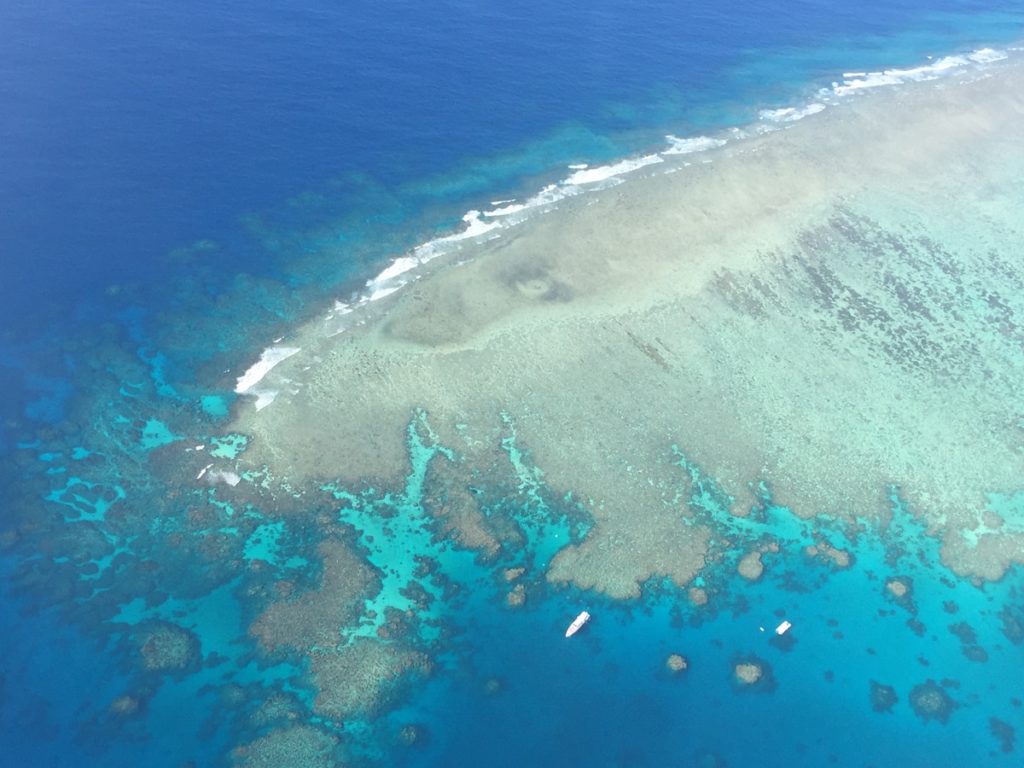
Best time to visit the Great Barrier Reef
The climate in Australia varies greatly due to the vastness of the country. The Great Barrier Reef has a tropical climate and enjoys pleasant temperatures all year round. It has two seasons. The hot and humid summer from December to April, the dry and cooler winter from June to November.
The rainy season lasts from December to April, but be reassured, the islands of the Great Barrier Reef are much less watered than the mainland. The danger, however, can come from jellyfish… but everything should be fine with a full wetsuit!
Another solution is to choose an island very far south or far out (Brampton, Heron and Lady Elliot Island for example). These islands are never affected by jellyfish.
Finally, water temperatures vary from an average of 21 °C in winter to 27 °C in summer. Temperatures become increasingly warm as you move north.
The best time to dive on the Great Barrier Reef is therefore between April and November.
How long to plan to explore the Great Barrier Reef?
It all depends on the time you want to devote to its discovery. If you have little time, you can take a day trip for an overview. We still recommend dedicating 3 or 4 days to exploring this World Heritage Site. For example, plan a 2-day cruise and then an overflight of the Great Barrier Reef on the 3rd day! It is also important to plan a day to discover the beaches of the area. See below in our must-sees to give you an idea.

How to get to the Great Barrier Reef?
To observe the Great Barrier Reef, you will need to get there either by boat, small plane, or helicopter. Thus, you will have several options to observe the largest coral system in the world. If you have the opportunity and the budget, the best option to discover the reef is to go on a cruise for a few days (2 or 3 days is ideal). However, be careful, if you take a plane, remember that you must wait 24 hours before you can dive.
Not all islands of the Great Barrier Reef are accessible. Indeed, some are protected. The majority are still open to tourists. Some islands are national parks where you can camp and hike, others are more touristy with large hotels and various services.
Starting points for Great Barrier Reef excursions
To get to the Great Barrier Reef, the main access points are as follows:
Cairns: Most convenient and sought-after access. Most tour operators are based there.
Port Douglas: Less touristy and good access to Agincourt Ribbon Reef.
Cape Tribulation: Less frequented but less accessible and less choice of excursions.
Airlie Beach: Access to visit the Whitsundays. A beautiful spot but at the entrance of the Great Barrier Reef, so less interesting for snorkeling for example.
When you plan your visit to the Great Barrier Reef, it’s important to choose your starting point carefully, as it will affect the type of excursions you can take and the areas of the reef that you will have access to.

The must-sees of the Great Barrier Reef
As you’ve understood, the Great Barrier Reef extends over hundreds of kilometers and has a lot of islands and islets. So, what are the must-sees of the Great Barrier Reef? For us, here are the activities not to be missed:
- Fly over Heart Reef in a helicopter or seaplane. One of the most magical moments of your life! We will guide you to the best companies.
- Take a 2-3 days cruise in the Whitsundays with snorkeling, diving, kayaking and swimming on the program. Several types of boats are available; catamaran, sailboat, yacht… Our favorite? Old fashioned sailboat with wooden hull!
- Spend some time on the most beautiful beach in Australia: visit Whiteheaven beach.
- Land and spend some time on a deserted and isolated sand bank! Located 43km north of Cairns, Michaelmas Cay is only 360×50 meters and offers you a unique feeling of the end of the world! You can snorkel and discover the different bird species that nest there: Brown Noddy, Crested Tern, Brown Booby, Greater Frigate Bird, Caspian Tern, Eastern Reef Heron… A unique experience where there will be only you and the birds!
- Dive on the Agincourt reef, a pinnacle teeming with life with caves and mini reefs growing all around! It brings together soft and hard corals and various species of fish of all colors.
- Go on an adventure for a few days of isolation on an uninhabited island, in Jurassic Park! The program is hiking and camping along the Thorsborne Trail on Hinchinbrook Island National Park. Located between Cairns and Townville, it is known for its hikes that offer an impressive diversity of landscapes for its 2,807 km2. You will see mangroves, eucalyptus forests, sections of tropical jungle and mountains reaching 1,121 meters high.
- Visit the beautiful islands of the Reef such as
- Green Island, Fitzroy, Hayman, Lizard Island: from Cairns
- Magnetic Island, Orpheus Island: from Townsville
- Whitsundays, Hamilton, Hayman, Daydream: from Airlie Beach
- Gladstone Island, Heron Island: from Gladstone
- Lady Elliot: from Gold Coast, Bundaberg et Hervey Bay.
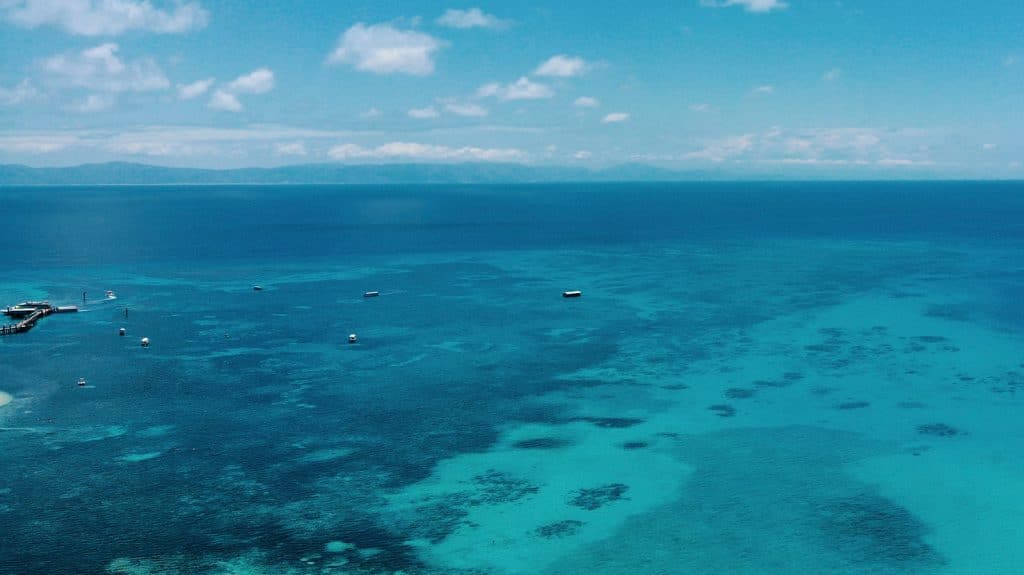
Wildlife to discover on the Great Barrier Reef
An incomparable marine biodiversity
This archipelago of coral, islands and sandy cays is home to a unique concentration of species, some of which are endemic:
- Over 400 types of coral
- 1,500 types of tropical fish
- 20 types of reptiles, including sea turtles
- 200 types of birds
- Rays, sharks, tuna, dugongs, dolphins and humpback whales that migrate from Antarctica!
Dangers to be aware of
The north-east of Queensland presents some dangers but if simple rules of common sense are respected, there is no reason to worry.
- Jellyfish: avoid swimming between October and May. Even if jellyfish are less present around the islands and coastlines, protective nets are installed annually on the busiest beaches (Port Douglas, Palm Cove, Mission Beach, etc.). This site is very useful for finding out about Queensland beach nets. You can also learn about dangerous jellyfish in Australia.
- Stone Fish: A fish with deadly poison spines. This fish stays on sandbanks or submerged rocks. It is not common to come across them but it is advisable to look under the water before setting foot there.
- Salt water crocodile: these crocodiles can be present in Queensland waters between October and May, during the rainy season. They flee excessively heavy rains, travel to find new territory, hunt, reproduce… Avoid swimming during this period and do not walk on the beaches at night.
- Strong currents can pose a risk to divers of all experience levels, particularly in the passages between islands and reefs.
- Weather conditions can change rapidly, affecting visibility and diving safety.
This information may be worrying at first sight, however the inhabitants of Queensland as well as the tourism operators know their environment and the good behavior to follow. Very few accidents are recorded each year and this state remains the most touristic in Australia, rightly so.
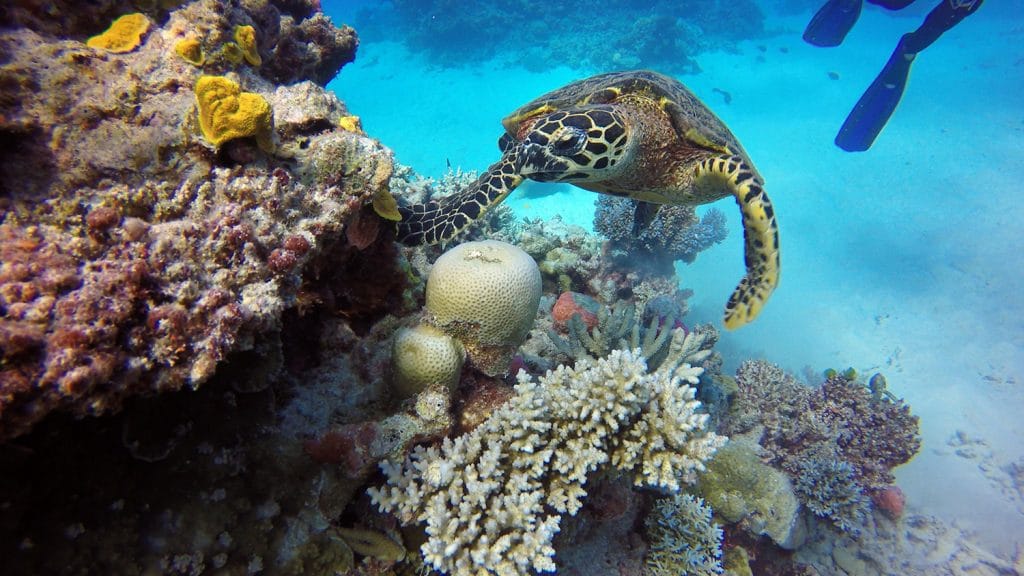
Threats to the Great Barrier Reef
Even though it is increasing in size, the Great Barrier Reef is an extremely fragile ecosystem. It is moving slowly towards the south, which benefits from warmer waters due to global warming. Other factors are damaging the Great Barrier Reef a little more every day, including intensive fishing, disrespectful divers and chemical pollution, including the sun creams used by bathers…
Some scientists even estimate that by 2050 only 5% of live corals will remain. Fortunately, the Australian government is well aware of these environmental issues and has launched new measures to protect the Great Barrier Reef in 2004.
Endangered species
The sea turtle (Green Sea Turtle) that has inhabited the oceans for 150 million years. Six of the seven species of sea turtles are present in the Great Barrier Reef and all six of them are threatened. The dugong is the only marine mammal that feeds exclusively on plants. There are 1,400 dugongs living at the Great Barrier Reef.
Humpback whales, visible in the region between May and September. They spend the summer in the polar regions where food is abundant, then come to the warm waters of Australia in winter to mate . They are protected and some species are threatened.
Dugong is the only marine mammal that feeds exclusively on plants. There are only 1,400 dugongs on the Great Barrier Reef. Innovative surveillance techniques, such as aerial surveys, are used to monitor dugong populations, which are essential to the health of marine ecosystems.
How to preserve coral
Here are a few tips to minimise your impact during your visit:
- Visiting: Use toilets as much as possible, take your garbage, check your belongings for insects (or any other living species) before visiting.
- Excursion: Don’t stand on corals, don’t touch them, try not to frighten any animals, don’t feed any fish, and take your time!
- Camping: Take your garbage back to the mainland, obtain a permit from the Queensland Parks and Wildlife Service, camp only on the designated sites, don’t make fires in the national parks, don’t use detergent near the water, use sand to clean your dishes.
Conservation efforts
The recent conservation efforts for the Great Barrier Reef and the positive outcomes are varied and reflect a growing commitment towards the protection of this unique ecosystem. Here are some initiatives worth noting:
- Combat against the crown-of-thorns starfish: These starfish are natural predators of corals and can cause significant damage to reefs. Monitoring and control programs have been implemented to manage the populations of these starfish and protect the corals.
- Coral IVF (In Vitro Fertilization of Corals). This innovative technique involves collecting coral gametes during the spawning period and fertilizing them in the laboratory. The coral larvae are then returned to the ocean to increase survival chances and aid in reef regeneration.
- Initiatives are underway to protect and restore essential habitats, such as mangroves and seagrass beds, which are vital for many marine species and for water quality.
- Educational programs are being set up to raise public and tourist awareness of the importance of the Great Barrier Reef and the actions they can take to contribute to its preservation. Although these efforts have led to notable improvements, such as increased coral coverage in some areas, scientists remain cautious.
These successes are fragile, and the sustainability of the recovery heavily depends on the continuation of conservation efforts and the fight against global threats such as climate change.






















